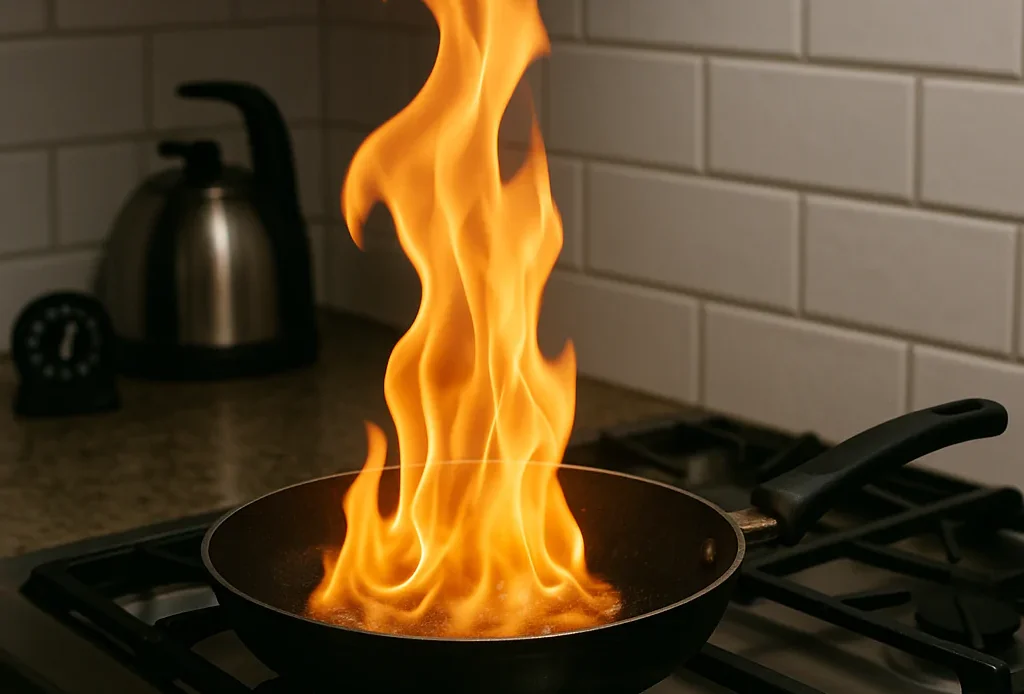A kitchen grease fire can ignite in seconds, turning a simple meal prep into a dangerous situation. Understanding how to prevent, extinguish, and clean up after such fires is crucial for every homeowner. Let’s dive into the essentials to keep your kitchen safe and sound.
🛡️ Prevention: Keeping Grease Fires at Bay
👀 Stay Vigilant While Cooking
- Never leave cooking unattended. Unattended cooking is a leading cause of kitchen fires.
- Monitor oil temperatures. If oil starts to smoke, it’s too hot and can ignite.
- Keep flammable items away. Ensure items like paper towels, dishcloths, and wooden utensils are kept away from the stovetop.
🧽 Maintain a Clean Cooking Area
- Regularly clean stovetops and ovens. Built-up grease can catch fire easily.
- Clean exhaust fans and filters. Grease accumulation in vents can be a hidden fire hazard.
🧯 Equip Your Kitchen with Safety Tools
- Keep a Class K fire extinguisher nearby. Specifically designed for kitchen fires.
- Have a metal lid or baking sheet accessible. Useful for smothering flames.
- Consider a fire blanket. Effective in extinguishing small fires without mess.
🚨 Responding to a Grease Fire
❌ What NOT to Do
- Do NOT use water. Water can cause the burning oil to splatter and spread the fire.
- Avoid moving the pan. This can cause hot oil to spill, leading to burns or spreading the fire.
✅ Steps to Extinguish the Fire
- Turn off the heat source. This stops feeding the fire.
- Cover the flames with a metal lid or baking sheet. This deprives the fire of oxygen.
- Use baking soda or salt. These can smother small fires.
- Use a Class K fire extinguisher if necessary. Only if the above steps don’t work.
- Call 911 if the fire persists. Safety first!
🧹 Cleaning Up After a Grease Fire
🧼 Initial Cleanup Steps
- Ensure the area is safe. Wait until all surfaces have cooled.
- Ventilate the kitchen. Open windows and use fans to disperse smoke.
- Wear protective gear. Gloves and masks can protect against soot and fumes.
🧽 Deep Cleaning Tips
- Use a degreaser or a mixture of vinegar and water. Effective for cleaning soot and grease.
- Clean all affected surfaces. This includes cabinets, appliances, and walls.
- Wash or discard contaminated fabrics. Smoke can permeate towels, curtains, and clothing.
- Check and replace HVAC filters. Smoke particles can linger in the system.
🧠 FAQs
❓ Q. Can I use flour to extinguish a grease fire?
No. Flour is combustible and can exacerbate the fire.
❓ Q. How often should I clean my kitchen exhaust system?
Regularly. Depending on usage, clean every 3-6 months to prevent grease buildup.
❓ Q. Is it safe to use the kitchen immediately after a grease fire?
Not immediately. Ensure all residues are cleaned, and the area is ventilated before resuming use.
🏠 Need Professional Help?
If a grease fire has caused significant damage or if you’re unsure about the cleanup process, ERX (Emergency Restoration Xperts) is here to assist. Our team specializes in fire damage restoration, ensuring your kitchen is safe and restored to its former glory.

